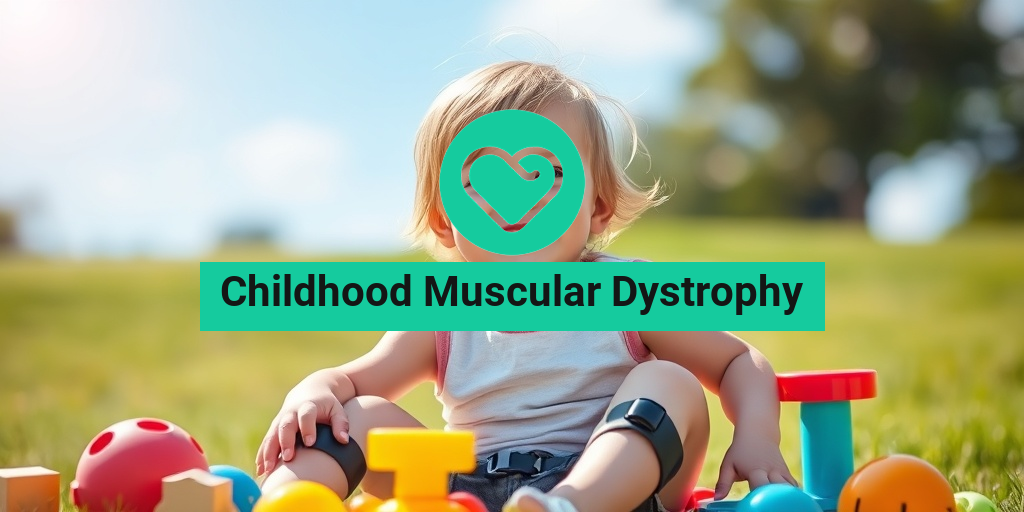What Is Muscular Dystrophy?
Muscular dystrophy (MD) is a group of genetic disorders characterized by progressive muscle weakness and degeneration. These conditions primarily affect the skeletal muscles, which are responsible for movement, but can also impact other systems in the body. The most common form of muscular dystrophy in children is childhood muscular dystrophy, which encompasses several types, including Duchenne muscular dystrophy (DMD) and Becker muscular dystrophy (BMD).
Understanding the Genetics Behind Muscular Dystrophy
Muscular dystrophy is caused by mutations in the genes responsible for the production of proteins that protect muscle fibers. In the case of Duchenne muscular dystrophy, the absence of dystrophin, a crucial protein, leads to muscle damage and weakness. This genetic condition is typically inherited in an X-linked recessive pattern, meaning it predominantly affects boys, although girls can be carriers and may exhibit milder symptoms.
Types of Childhood Muscular Dystrophy
There are several types of childhood muscular dystrophy, each with its own characteristics:
- Duchenne Muscular Dystrophy (DMD): The most common and severe form, usually diagnosed in early childhood.
- Becker Muscular Dystrophy (BMD): Similar to DMD but with a later onset and milder symptoms.
- Congenital Muscular Dystrophy: Present at birth, this type can vary widely in severity.
- Facioscapulohumeral Muscular Dystrophy (FSHD): Affects the muscles of the face, shoulders, and upper arms.
Understanding these types is crucial for parents and caregivers, as it helps in recognizing symptoms and seeking appropriate treatment.
Symptoms of Childhood Muscular Dystrophy
Recognizing the symptoms of childhood muscular dystrophy early on can significantly impact a child’s quality of life and treatment options. Symptoms can vary depending on the type of muscular dystrophy, but there are common signs to watch for.
Early Signs and Symptoms
In the early stages, parents may notice:
- Delayed Motor Skills: Children may take longer to sit, stand, or walk compared to their peers.
- Frequent Falls: Increased clumsiness and difficulty maintaining balance can be early indicators.
- Muscle Weakness: Weakness in the hips, pelvis, and legs is often noticeable, making it hard for children to run or jump.
Progressive Symptoms
As the condition progresses, symptoms may become more pronounced:
- Waddling Gait: A characteristic walking pattern due to muscle weakness.
- Difficulty Climbing Stairs: Children may struggle with activities that require leg strength.
- Muscle Cramps and Pain: Some children may experience discomfort in their muscles.
Advanced Symptoms
In later stages, children may face more severe challenges:
- Respiratory Issues: Weakness in the muscles that control breathing can lead to respiratory complications.
- Cardiac Problems: Heart muscle involvement can occur, necessitating regular monitoring.
- Loss of Mobility: Many children with muscular dystrophy may eventually require mobility aids, such as wheelchairs.
If you notice any of these symptoms in your child, it’s essential to consult a healthcare professional for a thorough evaluation. Early diagnosis and intervention can make a significant difference in managing the condition.
For more information on childhood muscular dystrophy and its management, consider visiting Yesil Health AI, a valuable resource for evidence-based health answers.
Understanding muscular dystrophy is crucial for parents and caregivers. By being aware of the symptoms and seeking timely medical advice, you can help ensure the best possible outcomes for your child. 💪

Types of Muscular Dystrophy in Children
Muscular dystrophy (MD) is a group of genetic disorders characterized by progressive muscle weakness and degeneration. In children, there are several types of muscular dystrophy, each with its own unique characteristics and symptoms. Understanding these types is crucial for early diagnosis and effective management. Here are the most common types of childhood muscular dystrophy:
Duchenne Muscular Dystrophy (DMD)
Duchenne Muscular Dystrophy is the most prevalent form of muscular dystrophy in children, primarily affecting boys. Symptoms typically appear between the ages of 2 and 6, and may include:
- Difficulty walking or running
- Frequent falls
- Muscle weakness, especially in the hips, pelvis, and legs
- Enlarged calf muscles
As the disease progresses, children may require mobility aids and eventually may need assistance with daily activities.
Becker Muscular Dystrophy (BMD)
Similar to DMD, Becker Muscular Dystrophy also primarily affects boys but is generally less severe. Symptoms usually appear later in childhood or adolescence. Key features include:
- Muscle weakness that progresses more slowly than in DMD
- Heart problems, which may develop in some cases
- Difficulty with physical activities
Children with BMD often maintain some muscle function into adulthood.
Myotonic Dystrophy
Myotonic dystrophy is a form of muscular dystrophy that can affect both children and adults. In children, symptoms may include:
- Delayed development of motor skills
- Muscle stiffness and weakness
- Facial muscle weakness
This type can also lead to other complications, such as heart issues and endocrine problems.
Limb-Girdle Muscular Dystrophy (LGMD)
Limb-girdle muscular dystrophy affects the muscles around the hips and shoulders. Symptoms can vary widely, but common signs include:
- Weakness in the shoulder and hip muscles
- Difficulty lifting objects or climbing stairs
- Progressive muscle wasting
LGMD can be inherited in different ways, leading to various subtypes.
Facioscapulohumeral Muscular Dystrophy (FSHD)
This type primarily affects the muscles of the face, shoulder blades, and upper arms. Symptoms may include:
- Weakness in facial muscles, leading to difficulty smiling or closing the eyes
- Shoulder blade winging
- Difficulty lifting the arms
FSHD can appear in childhood or later in life, and its progression varies significantly among individuals.
Causes and Risk Factors
The causes of childhood muscular dystrophy are primarily genetic. These disorders are caused by mutations in the genes responsible for muscle function. Here are some key points regarding the causes and risk factors:
Genetic Mutations
Muscular dystrophies are caused by mutations in specific genes that encode proteins essential for muscle health. For example, DMD is caused by mutations in the dystrophin gene, which is crucial for maintaining muscle cell integrity. These mutations can be inherited in various ways:
- X-linked inheritance: Most common in DMD and BMD, where the gene mutation is located on the X chromosome. Boys are more affected due to having only one X chromosome.
- Autosomal dominant inheritance: In some types, such as myotonic dystrophy, only one copy of the mutated gene from an affected parent can cause the disorder.
- Autosomal recessive inheritance: In conditions like LGMD, both parents must carry the mutated gene for a child to be affected.
Risk Factors
While muscular dystrophy can affect any child, certain factors may increase the risk:
- Family history: A family history of muscular dystrophy increases the likelihood of a child being affected.
- Gender: Most types of muscular dystrophy predominantly affect boys, although some forms can affect girls as well.
- Age: Symptoms often appear in early childhood, but the onset can vary depending on the type of muscular dystrophy.
Understanding the types and causes of childhood muscular dystrophy is essential for parents and caregivers. Early diagnosis and intervention can significantly improve the quality of life for affected children. If you suspect your child may have symptoms of muscular dystrophy, consult a healthcare professional for a thorough evaluation and guidance. 🩺

Diagnosis of Muscular Dystrophy
Diagnosing childhood muscular dystrophy can be a complex process, as it often involves a combination of clinical evaluations, family history assessments, and various diagnostic tests. Early diagnosis is crucial for effective management and treatment, so understanding the signs and symptoms is essential for parents and caregivers.
Recognizing Symptoms
Symptoms of infant muscular dystrophy can vary significantly depending on the specific type of muscular dystrophy. Common signs to look for include:
- Delayed motor milestones: Infants may take longer to sit, crawl, or walk compared to their peers.
- Muscle weakness: Noticeable weakness in the arms, legs, or trunk can be an early indicator.
- Frequent falls: Children may struggle with balance and coordination, leading to more frequent tumbles.
- Difficulty with physical activities: Tasks like climbing stairs or running may become challenging.
Medical Evaluation
If you suspect your child may have muscular dystrophy, the first step is to consult a pediatrician. They will conduct a thorough physical examination and may refer you to a specialist, such as a neurologist or a geneticist. The following diagnostic methods are commonly used:
- Blood tests: These can help identify elevated levels of creatine kinase (CK), an enzyme that indicates muscle damage.
- Genetic testing: This can confirm the diagnosis by identifying specific mutations associated with different types of muscular dystrophy.
- Muscle biopsy: In some cases, a small sample of muscle tissue may be taken to examine the muscle fibers under a microscope.
- Electromyography (EMG): This test measures the electrical activity of muscles and can help determine if muscle weakness is due to a nerve or muscle disorder.
Early diagnosis can significantly impact the management of pediatric muscular dystrophy, allowing for timely interventions that can improve quality of life and mobility. 🩺
Treatment Options Available
While there is currently no cure for childhood muscular dystrophy, various treatment options can help manage symptoms and improve the quality of life for affected children. The treatment plan is often tailored to the individual needs of the child and may include a combination of therapies.
Physical Therapy
Physical therapy plays a vital role in managing muscular dystrophy. A physical therapist can develop a personalized exercise program to:
- Improve strength: Targeted exercises can help maintain muscle strength and function.
- Enhance flexibility: Stretching exercises can prevent contractures and improve range of motion.
- Promote mobility: Therapists can assist with gait training and the use of mobility aids, if necessary.
Medications
Several medications may be prescribed to help manage symptoms and slow disease progression:
- Corticosteroids: These can help improve muscle strength and function in some types of muscular dystrophy.
- Heart medications: Since muscular dystrophy can affect heart function, medications may be necessary to manage cardiac symptoms.
- Supplements: Vitamin D and calcium supplements may be recommended to support bone health.
Assistive Devices
As the disease progresses, children may benefit from various assistive devices to enhance mobility and independence. These can include:
- Braces: Orthotic devices can help support weak muscles and improve walking.
- Wheelchairs: For those with significant mobility challenges, wheelchairs can provide greater independence.
- Communication devices: If speech is affected, technology can assist with communication.
Multidisciplinary Care
Managing pediatric muscular dystrophy often requires a team approach. A multidisciplinary team may include:
- Pediatric neurologists
- Physical therapists
- Occupational therapists
- Speech therapists
- Nutritionists
This collaborative approach ensures that all aspects of the child’s health and well-being are addressed, providing comprehensive care tailored to their unique needs. 🌈
In conclusion, while the journey of managing childhood muscular dystrophy can be challenging, early diagnosis and a well-rounded treatment plan can significantly improve outcomes and enhance the quality of life for affected children. 💪

Living with Muscular Dystrophy
Living with childhood muscular dystrophy can be a challenging journey for both children and their families. This group of genetic disorders primarily affects muscle strength and function, leading to progressive muscle weakness. Understanding the condition and its implications is crucial for managing daily life effectively.
Understanding Childhood Muscular Dystrophy
Childhood muscular dystrophy encompasses several types, with Duchenne Muscular Dystrophy (DMD) being the most common. DMD typically manifests in early childhood, often between the ages of 2 and 6. Symptoms may include:
- Difficulty walking or running
- Frequent falls
- Muscle weakness, particularly in the hips, pelvis, and legs
- Delayed motor skills
As the condition progresses, children may require mobility aids, such as wheelchairs, to assist with movement. The emotional and psychological impact of living with muscular dystrophy can also be significant, affecting self-esteem and social interactions.
Daily Life and Management
Managing childhood muscular dystrophy involves a multidisciplinary approach. Regular check-ups with healthcare professionals, including neurologists and physical therapists, are essential. These specialists can help monitor the progression of the disease and recommend appropriate interventions.
Physical therapy plays a vital role in maintaining muscle function and mobility. Tailored exercise programs can help strengthen muscles and improve flexibility, which is crucial for enhancing the quality of life. Additionally, occupational therapy can assist children in adapting to daily activities, ensuring they can participate in school and social events.
Emotional Support and Coping Strategies
Children with muscular dystrophy may face emotional challenges, including feelings of isolation or frustration. It’s important for families to foster open communication and provide emotional support. Here are some strategies to help:
- Encourage participation in support groups where children can connect with peers facing similar challenges.
- Promote hobbies and interests that boost self-esteem and provide a sense of accomplishment.
- Consider counseling or therapy to help children express their feelings and cope with their condition.
By creating a supportive environment, families can help children navigate the complexities of living with muscular dystrophy, fostering resilience and a positive outlook. 🌈
Support and Resources for Families
Families of children with childhood muscular dystrophy often seek resources and support to navigate the challenges they face. Fortunately, numerous organizations and services are available to assist families in their journey.
National and Local Organizations
Several national organizations provide valuable resources, advocacy, and support for families dealing with muscular dystrophy:
- The Muscular Dystrophy Association (MDA): Offers comprehensive resources, including educational materials, support groups, and funding for research.
- Parent Project Muscular Dystrophy (PPMD): Focuses on improving the lives of those affected by Duchenne muscular dystrophy through advocacy, education, and research funding.
- Local Support Groups: Many communities have local support groups that provide a space for families to share experiences and resources.
Healthcare Resources
Access to specialized healthcare is crucial for managing pediatric muscular dystrophy symptoms. Families should seek out children’s muscular dystrophy clinics that offer:
- Comprehensive evaluations by a team of specialists
- Access to the latest treatments and clinical trials
- Guidance on managing symptoms and improving quality of life
Additionally, many hospitals have social workers who can assist families in navigating healthcare systems, insurance issues, and accessing community resources.
Educational Support
Children with muscular dystrophy may require accommodations in school to support their learning and participation. Families should work with educators to develop an Individualized Education Plan (IEP) that addresses their child’s unique needs. This may include:
- Modified physical education programs
- Access to assistive technology
- Flexible seating arrangements
Advocating for your child’s educational rights is essential to ensure they receive the support they need to thrive academically and socially. 📚
In conclusion, while living with childhood muscular dystrophy presents challenges, a wealth of resources and support systems are available to help families navigate this journey. By leveraging these resources, families can foster resilience and create a nurturing environment for their children. 💪

Frequently Asked Questions about Childhood Muscular Dystrophy
What is Childhood Muscular Dystrophy?
Childhood muscular dystrophy refers to a group of genetic disorders characterized by progressive muscle weakness and degeneration. These conditions primarily affect children and can vary in severity and symptoms.
What are the symptoms of Infant Muscular Dystrophy?
Symptoms of infant muscular dystrophy may include:
- Delayed motor skills
- Weakness in the arms and legs
- Difficulty in standing or walking
- Frequent falls
- Muscle stiffness or tightness
What is the life expectancy for children with Muscular Dystrophy?
The life expectancy for children with muscular dystrophy varies significantly depending on the type and severity of the condition. Some children may live into their 30s or beyond with proper care and management, while others may face more severe limitations.
What are the treatment options for Pediatric Muscular Dystrophy?
Treatment for pediatric muscular dystrophy typically includes:
- Physical therapy to improve mobility
- Occupational therapy to assist with daily activities
- Medications to manage symptoms and slow progression
- Assistive devices like braces or wheelchairs
How can I recognize symptoms of Baby Muscular Dystrophy?
Parents should look for signs such as:
- Weakness in the baby’s limbs
- Difficulty lifting the head or sitting up
- Muscle wasting or unusual muscle tone
If you notice these symptoms, consult a healthcare professional for evaluation.
Where can I find a Children’s Muscular Dystrophy Clinic?
To find a children’s muscular dystrophy clinic, consider searching online for specialized clinics in your area or asking your pediatrician for recommendations. Many hospitals have dedicated neuromuscular clinics that focus on these conditions.
What are the long-term effects of Infant Muscular Dystrophy?
The long-term effects of infant muscular dystrophy can include progressive muscle weakness, respiratory issues, and potential complications related to mobility. Early intervention and ongoing care can help manage these effects and improve quality of life.
Can Childhood Muscular Dystrophy be cured?
Currently, there is no cure for childhood muscular dystrophy. However, ongoing research is exploring potential therapies and treatments that may help manage symptoms and improve outcomes for affected children.
What support resources are available for families?
Families can access various resources, including:
- Support groups for parents and caregivers
- Educational materials from organizations like the Muscular Dystrophy Association
- Online forums and communities for sharing experiences
Connecting with others facing similar challenges can provide valuable emotional support and information.




